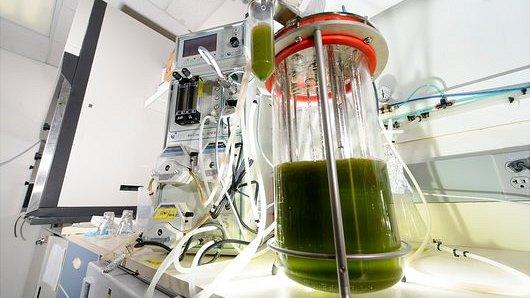Can eating meat be eco-friendly?
- Published

The problem lies with what cows eat, says Dr Mosley
Every year we raise and eat 65 billion animals, that's nine animals for every person on the globe, and it's having a major impact on our planet. So what meat should we eat if we want to be eco-friendly carnivores? Is it better to buy beef or chicken, free range or factory farmed? As Dr Michael Mosley discovers for BBC Horizon, the answers are far from obvious.
I like eating meat but I know that my food preferences, and those of a few billion fellow carnivores, comes at a cost.
Nearly a third of the Earth's ice-free land surface is already devoted to raising the animals we either eat or milk.
Roughly 30% of the crops we grow are fed to animals. The latest UN Food and Agriculture Organisation reports suggest livestock are responsible for 14.5% of man-made greenhouse gas emissions - the same amount produced by all the world's cars, planes, boats and trains.
If that wasn't scary enough, meat consumption is predicted to double in the next 40 years as people globally get wealthier. So how will the world cope?
Greenhouse gas
In search of answers I went to the US, one of the world's largest consumers of meat, and travelled to the wide-open prairies of the Flint Hills in Kansas.
Here cattle are still herded by cowboys and cowgirls, as they have been for 150 years. The cows spend their lives roaming the hills, eating grass until it is time for them to be slaughtered. It seems to be an idyllic form of farming.
Yet there's a big problem. Armed with a laser methane detector, normally used to spot dangerous gas leaks, I dived into a herd of cows and was soon picking up readings that would have had me sounding the alarms if I had been on an oil rig. These cows are producing huge amounts of methane.
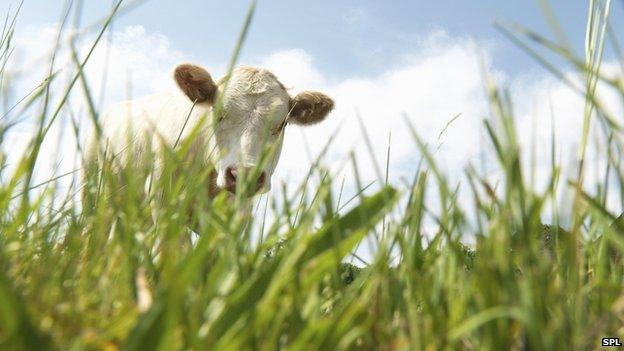
Grass eaters produce methane gas, which is harmful to the environment
A single cow can belch up to 500 litres of methane every day. Multiply that by the 1.5 billion cattle we have on our planet and that's a lot of gas. And it has a vast environmental impact because methane is 25 times more potent a greenhouse gas than carbon dioxide.
The problem lies in what the cows eat. Unlike most mammals, cattle can live on a diet of grass, thanks to the trillions of microbes that live in their many stomachs.
These microbes break down the cellulose in grass into smaller, nutritious molecules that the cows digest, but while doing so the microbes also produce huge amounts of explosive methane gas which the cows burp out.
Since grass is what fuels methane production, one way to reduce the belching is to change what the cows eat.
At a feedyard in Texas I saw a very different type of farming, thousands of cattle confined in grass-free, mud enclosures and fed a diet based on a carefully formulated mix of corn, fat, growth hormones and antibiotics.
It looked the opposite of eco-friendly farming. Yet the CEO, Mike Engler, argued that his way of farming is "greener" than raising cows on the prairies - that their greater efficiency leads to less environmental impact.
The scientifically formulated diet means his cows put on weight faster and produce far less methane than cattle reared the traditional way. Studies have shown that beef produced this way produces up to 40% less methane than grass-fed cattle.
It is a form of farming that is yet to become widespread in the UK. But in terms of emissions, intensively reared, corn fed cattle may be the most environmentally friendly. However I couldn't look at the cows without having some concern for their welfare and wondering whether this is how I want our Sunday roast to live.
So what else can we do to reduce the environmental impact of the meat we eat?

Eco-friendly meat
Through a technique called Life Cycle Analysis scientists have been able to put figures on the environmental impact of different meats.
The worst offenders are the grass-eating, methane-producing animals such as cows and sheep.
Pigs and chickens, which eat a more mixed diet, fare better.
Mussels are very eco-friendly, taking relatively little energy to rear.

Well, we can choose which animals we eat. Not all animals create meat equally. Through a technique called Life Cycle Analysis scientists have been able to put figures on the environmental impact of different meats (exact figures vary depending on the farming systems, but the following figures are broadly true of the meat you can buy in British supermarkets).
The worst offenders are the grass-eating, methane-producing animals. Cows release the equivalent of 16kg of carbon dioxide for every kilo of meat produced. Sheep are only slightly better producing 13kg of CO2 for every kilo of meat.
Pigs and chickens, which eat a more mixed diet, are much better. Pigs produce about half as much carbon dioxide, and chickens are responsible for only 4.4kg of CO2 per kilo of meat.
So if you are worried about your carbon footprint you are much better off eating chicken than beef. And, perhaps uncomfortably for some, the most eco-friendly chickens (in terms of carbon emissions) may not be organic or free-range, but those that are raised intensively in energy efficient indoor farms.
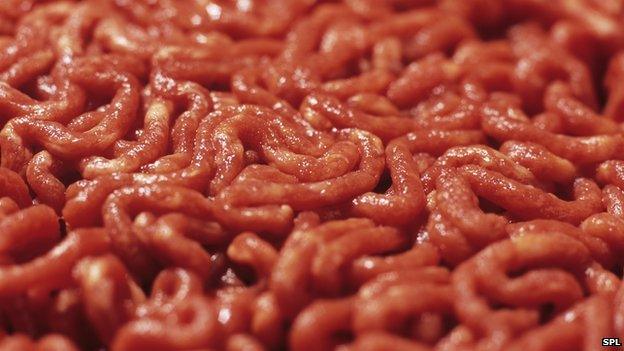
Not all animals create meat equally - cows are some of the least eco-friendly culprits in terms of their environmental impact
Another strategy is to find alternative sources of animal protein. Insects, farmed fish and even laboratory grown artificial meat are all touted as potential replacements, yet all currently have significant drawbacks.
Insects are unpalatable, farmed fish comes with other environmental draw-back and laboratory grown meat is still far too expensive to produce. But there are other alternatives right on our doorstep.
Surprisingly, the most eco-friendly source of meaty protein I encountered was also the lowest tech - mussels.
Grown on lengths of rope hung beneath the surface of sea loch in the Shetlands, it takes relatively little energy to rear mussels and get them from the sea to our plates. They even have the added bonus of capturing carbon dioxide and locking it up in their shells.
The result it that their carbon footprint is 20 times less than chicken, and fifty times less than beef. If we really want to cut down the environmental impact of our diets we should perhaps be eating more mussels. What we really need now are more imaginative ways of cooking them. Chilli mussels anyone?
But for many environmentalists the carbon footprint argument is too narrow. It may help us find the most energy-efficient way of producing meat, but that may not be the best way of using our land and resources.
In the programme we explore a very different way of having our meat and minimizing the impact on our environment. In some ways it involves going back to more traditional farming, but it also relies on cutting waste and eating less meat overall.
If you really want to be an environmentally friendly carnivore, your best bet is to stick to less than 100 gms (3 oz) of meat per day. That's about half what we currently eat.
Horizon - Should I Eat Meat? How to Feed The Planet is broadcast on BBC Two at 9pm on Wednesday, 20 August.
- Published18 August 2014
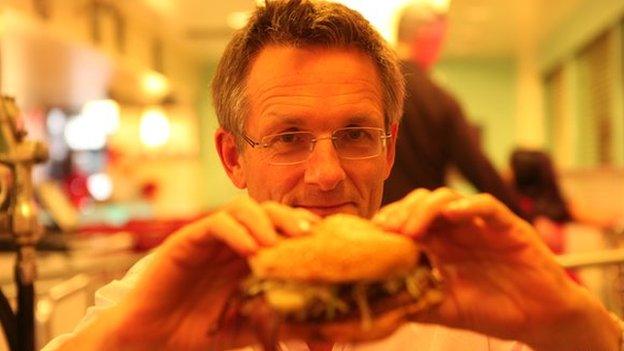
- Published9 January 2014
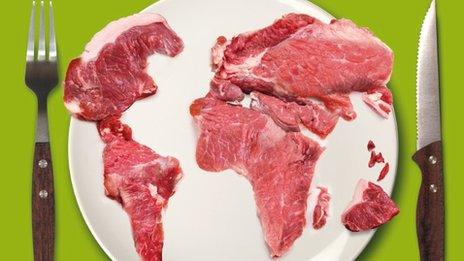
- Published23 July 2013
